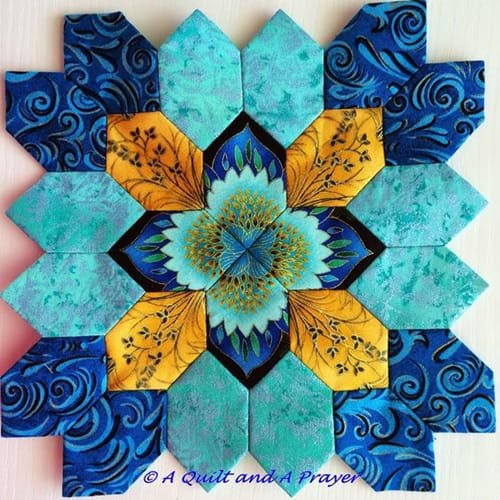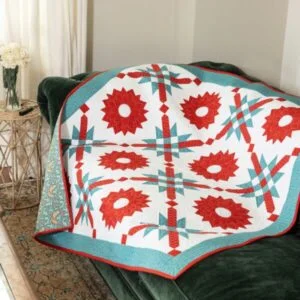In this Lucy Boston ‘Patchwork of the Crosses‘ – Tutorial, we will explore the delightful world of patchwork quilting inspired by the remarkable designs of Lucy Boston.
This unique quilting method combines creativity and precision, allowing quilters to create stunning geometric patterns. Whether you’re an experienced quilter or just starting out, this tutorial will provide you with the necessary steps to craft your own Patchwork of the Crosses masterpiece.
The Patchwork of the Crosses design is characterized by its intricate patterns formed by piecing together hexagonal patches. This technique not only showcases your sewing skills but also offers a canvas for your artistic expression. By following the detailed instructions in this tutorial, you will gain a deeper understanding of the process involved in creating this beautiful quilt pattern.

As we delve into this tutorial, keep in mind that patience and practice are key to mastering the Lucy Boston ‘Patchwork of the Crosses‘ technique. Embrace the journey of quilting, and let each stitch tell a story. Let’s get started on creating your own piece of art with the Patchwork of the Crosses!
1. Understanding the Patchwork of the Crosses Design
The Patchwork of the Crosses design is a stunning visual representation of symmetry and balance, making it a popular choice among quilters. This design utilizes hexagonal shapes arranged in a cross pattern, allowing for a captivating display of colors and fabrics. Understanding the fundamentals of this design is crucial for successfully creating your quilt.
One of the essential aspects of the Patchwork of the Crosses is the selection of fabrics. It’s advisable to choose a mix of patterns and solid colors that complement each other. This not only enhances the visual appeal of your quilt but also reflects your personal style.
In addition to fabric choice, consider the scale of your prints. Large-scale prints may overwhelm the design, while smaller prints can blend beautifully. It’s all about achieving a balance that works for your overall quilt aesthetic.
Moreover, the color palette plays a significant role in the Lucy Boston ‘Patchwork of the Crosses‘ design. Think about the mood you want to convey with your quilt. Warm colors evoke comfort, while cool tones bring a sense of calm. Experiment with different color combinations until you find the one that resonates with you.
Lastly, familiarize yourself with the basic shapes involved in the Patchwork of the Crosses. Understanding how the hexagons interlock will help you visualize the final product. Practice drawing out the design on paper or using quilting software to get a clearer idea of how your quilt will come together.
By grasping the fundamentals of the Patchwork of the Crosses, you set the stage for a successful quilting experience. This knowledge will guide you throughout the tutorial, helping you to create a stunning quilt that showcases your skills and creativity.
2. Materials Needed for Your Quilt
Before embarking on your Lucy Boston ‘Patchwork of the Crosses‘ project, gathering the right materials is essential. Having everything on hand will streamline the quilting process and enhance your experience.
First and foremost, you will need a variety of fabrics. For a classic Patchwork of the Crosses quilt, consider cotton fabrics in different colors and patterns. Aim for at least five to seven different fabrics to create depth and interest in your design.
Next, prepare your quilting tools. You will need a rotary cutter, cutting mat, and ruler for accurate cutting of your fabric pieces. Additionally, a sewing machine is necessary for piecing your quilt together. Ensure your machine is in good working order and familiarize yourself with its functions.
Don’t forget about thread! Select a high-quality cotton thread that matches your fabric colors. A good thread will enhance the overall durability and appearance of your quilt.
You will also require templates for cutting your hexagons and cross shapes. These can be purchased or made at home using cardboard or plastic sheets. Having precise templates will ensure that your pieces fit together seamlessly.
Lastly, consider your quilting accessories. Pins, fabric scissors, and an iron are essential for assembling and finishing your quilt. With all these materials gathered, you’ll be well-prepared to begin your Patchwork of the Crosses journey.
3. Cutting and Assembling Your Quilt Pieces
With your materials ready, it’s time to dive into the exciting process of cutting and assembling your quilt pieces. This step is crucial for achieving the perfect fit and overall design.
Start by cutting your fabric into hexagonal shapes using your templates. Ensure that each hexagon is cut precisely to maintain uniformity throughout the quilt. This attention to detail will significantly impact the final appearance of your Lucy Boston ‘Patchwork of the Crosses‘ quilt.
Once you have cut all your hexagons, it’s time to cut the cross pieces. These shapes will be interspersed between the hexagons to create the distinctive pattern. Take your time during this step to ensure that all pieces are consistent in size.
Next, begin arranging your hexagons and cross pieces on a flat surface. Play around with different layouts until you find a combination that you love. This is where your creativity shines, and you can experiment with color placements and designs.
After finalizing your layout, start sewing the hexagons together. Pin them in place to prevent shifting while sewing. Use a quarter-inch seam allowance to ensure accurate piecing.
As you complete each section, press the seams open to reduce bulk and create a flatter finish. Continue this process until all pieces are assembled, and you will have the beautiful Patchwork of the Crosses pattern coming to life!
4. Quilting and Finishing Touches
Now that you have assembled your quilt top, it’s time to move on to the quilting process. This step not only adds dimension to your quilt but also secures the layers together.
First, prepare your quilt sandwich by layering your quilt top, batting, and backing fabric. Smooth out any wrinkles to ensure a flat surface. Once layered, use safety pins or basting spray to hold the layers together temporarily.
Next, decide on your quilting design. You can opt for simple straight-line quilting or more intricate free-motion quilting, depending on your skill level and preferences. If you’re new to quilting, straight-line quilting is a great way to start.
Begin quilting from the center of the quilt and work your way outwards. This helps to prevent any shifting of the layers. As you quilt, take your time and enjoy the process.
Once quilting is complete, trim any excess batting and backing fabric. Next, it’s time to add the binding. Cut your binding strips, sew them together, and attach them to the edges of your quilt.
Finally, give your quilt a good press to eliminate any wrinkles. Stand back and admire your stunning Lucy Boston ‘Patchwork of the Crosses‘ quilt—your hard work has paid off!
FAQ
1. What is the history behind the Patchwork of the Crosses?
The Patchwork of the Crosses design was popularized by Lucy Boston in the mid-20th century. It reflects a blend of traditional quilting techniques and contemporary design, making it timeless.
2. What type of fabric is best for the Patchwork of the Crosses?
Cotton fabric is highly recommended due to its durability and ease of use. Choose a variety of colors and patterns to enhance the quilt’s visual appeal.
3. How do I choose colors for my quilt?
Consider using a color wheel to select complementary colors. Experiment with different combinations to find the palette that resonates with your style.
4. Can I use pre-cut fabric for this project?
Absolutely! Pre-cut fabric can save time and ensure uniformity in your quilt pieces. Just make sure they are suitable for the Patchwork of the Crosses design.
5. How long does it take to complete a quilt?
The time it takes to finish a quilt varies based on skill level, size, and complexity of the design. Generally, a quilt can take anywhere from a few days to several weeks.
6. What is the best way to care for my finished quilt?
To maintain your quilt’s beauty, wash it in cold water and tumble dry on low heat. Avoid bleach to prevent fading, and store it in a cool, dry place when not in use.
Join our VIP broadcast list and gain access to exclusive patterns, all for free. As a VIP member, you’ll receive the best patterns daily, delivered directly to your device. ✨📱 It’s a unique opportunity to stay up-to-date with the latest trends and designs, curated just for you. Don’t miss out on enhancing your projects and discovering new inspirations with the best patterns every day! 🎨🔝
Conclusion
In this Lucy Boston ‘Patchwork of the Crosses‘ – Tutorial, we’ve journeyed through the various stages of creating a stunning quilt. From understanding the design and gathering materials to cutting, assembling, and finally quilting, each step contributes to your unique piece of art.
We hope this tutorial has inspired you to explore the world of patchwork quilting and to create your own beautiful Patchwork of the Crosses masterpiece. We invite you to share your thoughts and suggestions in the comments below. Your feedback is invaluable as we continue to share our passion for quilting!



